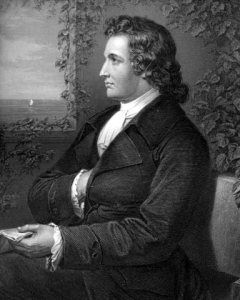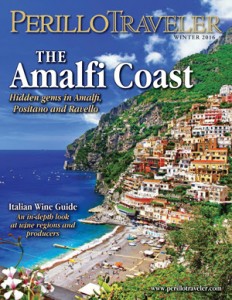 Johann Wolfgang von Goethe (1749-1832), a prolific and celebrated German writer and philosopher whose works include novels, poetry, memoirs, an autobiography, scientific writings, and drawings, also had ties to Italy. From 1786 to 1788, he embarked on a tour of Italy that greatly influenced his writings and philosophy.
Johann Wolfgang von Goethe (1749-1832), a prolific and celebrated German writer and philosopher whose works include novels, poetry, memoirs, an autobiography, scientific writings, and drawings, also had ties to Italy. From 1786 to 1788, he embarked on a tour of Italy that greatly influenced his writings and philosophy.
He published his first major scientific work,The Metamorphosis of Plants, in 1790, after he returned from Italy, and in 1816 published Italian Journey, an account of his first year in Italy. His poem Mignon’s Song, one of the most famous pieces of German poetry, also contains a reference to Italy in its well-known first line: “Do you know the land where the lemon trees bloom?”
Like many travelers, Goethe’s journey through Italy was inspired by his love for Greek and Roman art and architecture, but he discovered the full extent of Italy’s beauty, and the spirit of la dolce vita, along the way. Today, Goethe’s legacy lives on in Italy, and travelers can follow his path while imagining what it was like to travel the world in the 1700s, traversing the country by stagecoach and exploring little-traveled villages by foot.
He began in the Alps, traveling through the Brenner Pass (the border between Italy and Austria) from Munich by stagecoach. Once he reached the enchantingly blue Lake Garda, he was arrested on suspicion of being an Austrian spy, as he was drawing the ruins of a castle in the city of Malcesine, then part of the Republic of Venice, which was at war with Austria at the time. Fortunately, he was released, and his time in Malcesine is commemorated with a museum and a memorial.
At the Arena di Verona, Goethe saw what he had come to Italy to experience – an ancient monument – and was impressed with how well-preserved it was. In his first year in Italy, he traveled to Venice, and evidently enjoyed it so much that he spent much of his second year there (as he did not publish an account of his second year in Italy, it is unknown what exactly he did during that time).
Upon his arrival in Rome, on Nov. 1, 1786, he wrote, “I have eventually reached the capital of the world.” In his four months in the city, he partied, lived with another artist, and saw plenty of ancient structures. From Rome, he went to Naples, where he became popular with the locals when he challenged the idea that Italians were idle, a German stereotype of Italians at the time, and then on to Mount Vesuvius, which he climbed many times.
Perhaps Goethe’s favorite place in Italy was Sicily, of which he wrote in Italian Journey, “To have seen Italy without having seen Sicily is to not have seen Italy at all, for Sicily is the clue to everything.” He was particularly impressed with the views, especially from Monte Pellegrino, the array of plant life on the island, and the ancient Teatro Greco in Taormina with its backdrop of Mount Vesuvius. Goethe was one of the first tourists to visit Taormina, which is the most popular tourist town in Sicily today.
Goethe isn’t the only tourist to have been enamored with Italy, but he was among the first to write extensively about it, inspiring Germans to follow in his footsteps and drawing upon Italy’s influence in his works throughout the rest of his career.
By Kathy McCabe
Want to read more about travel? Get your free copy of our new digital magazine, Perillo Traveler!

